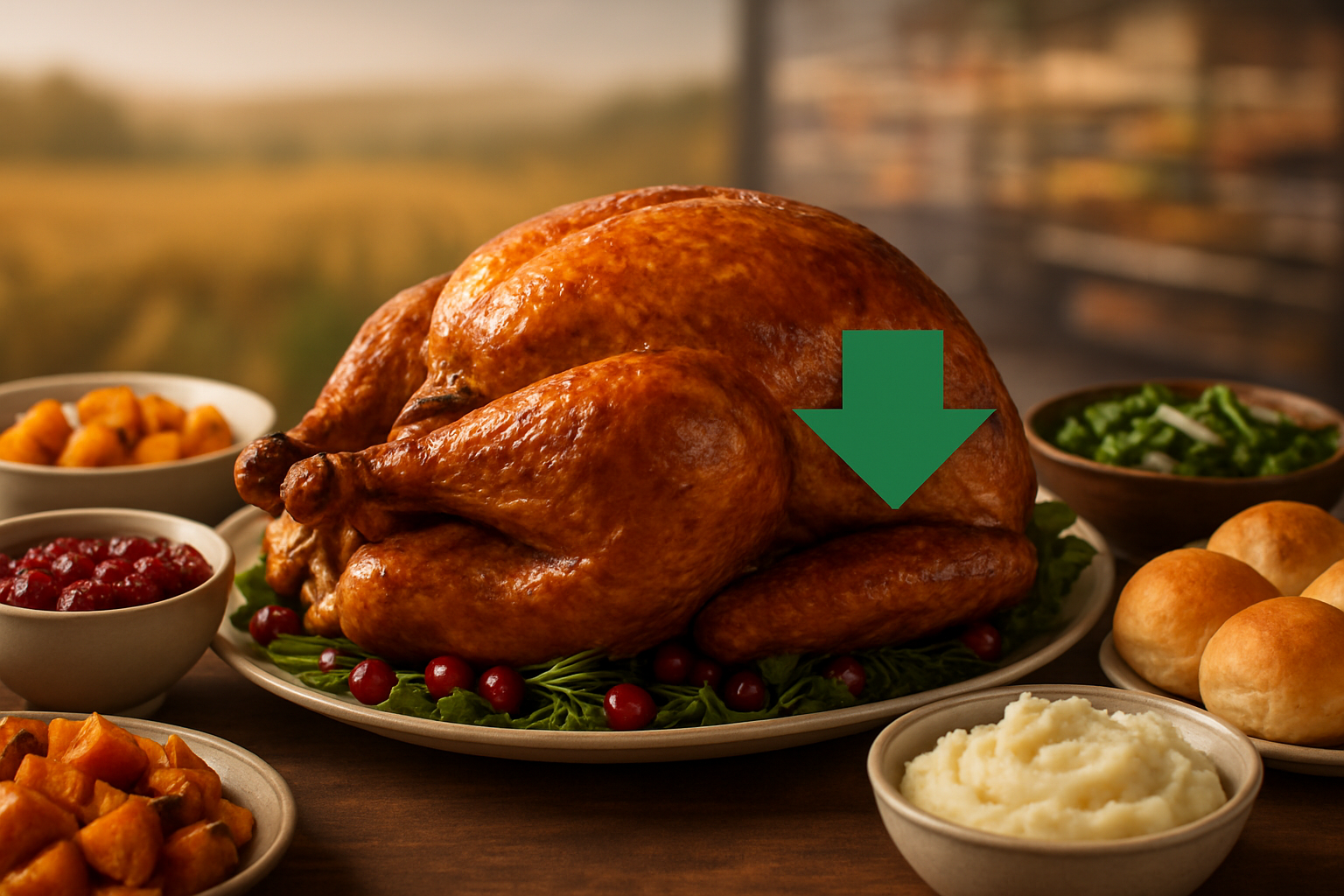
As families across the United States prepare for the quintessential Thanksgiving feast in 2025, a surprising trend is emerging: the centerpiece of the meal, the turkey, is expected to be notably cheaper. This unexpected dip in turkey prices, driven largely by strategic retail pricing and a gradual recovery in turkey flocks, offers a welcome respite for household budgets battling persistent food inflation. However, while the star of the show may be more affordable, the overall cost of the holiday dinner remains a complex tapestry of fluctuating commodity prices, with many traditional side dishes and staples continuing their upward climb.
This mixed financial outlook for Thanksgiving dinner has immediate implications for consumer spending and the broader agricultural sector. For consumers, it underscores a heightened need for value-seeking and strategic shopping, with many planning to purchase items earlier to capitalize on sales. For the agricultural sector, it highlights the intricate dance between production costs, supply chain vulnerabilities like avian influenza, and the aggressive pricing strategies of major retailers, all of which shape the final price tag for the holiday table.
The Balancing Act: Retailer Strategies Meet Agricultural Realities
The most striking development for Thanksgiving 2025 is the projected decrease in the cost of a whole turkey. The average 16-pound bird is anticipated to retail for approximately $21.50, or $1.34 per pound. This represents a significant 16.3% reduction from 2024 prices, marking a consumer-friendly shift. This decline at the consumer level is primarily attributed to fierce competition among major retailers, who are strategically pricing turkeys as "loss leaders" to draw shoppers into their stores, hoping they will purchase higher-margin items for the rest of their holiday meal. Furthermore, a partial recovery in turkey flocks from previous avian influenza outbreaks and a slight moderation in demand outside the immediate holiday season have contributed to this downward pressure on retail prices.
However, this consumer-friendly trend masks a contrasting reality in the wholesale market. Wholesale turkey prices have seen a substantial surge, with reports indicating increases of up to 75% since October 2024, reaching $1.71 per pound by October 2025. Other analyses show wholesale frozen turkey prices up 40% from 2024's average, hitting $1.32 per pound. This disparity is largely due to ongoing challenges within the agricultural sector. The U.S. turkey flock has reportedly shrunk to its lowest level in 40 years, with the U.S. Department of Agriculture (USDA) forecasting a 3-5% drop in total production for 2025 compared to 2024, primarily due to lingering avian flu outbreaks. Despite these wholesale increases and production shortfalls, the aggressive retail pricing strategies are expected to shield consumers from the full impact of the rising costs at the farm gate.
Beyond the turkey, the broader commodity landscape for Thanksgiving dinner presents a more inflationary picture. The USDA forecasts that overall food prices will increase by 3.0% in 2025, with food-at-home prices (groceries) expected to rise by 2.4%. This continues a trend where overall food prices are nearly 25% higher than they were in 2020. Many traditional Thanksgiving side dishes are experiencing significant price hikes: sweet potato prices are up 37%, vegetable trays (carrots and celery) have jumped 61.3%, frozen peas are up 17.2%, whole milk prices have risen 16.3%, and whipping cream is up 3.2%. These increases for fresh produce are partly due to weather-related disasters and ongoing farmworker shortages impacting the supply chain. While some items like cubed stuffing mix (-9%), dinner rolls (-14.6%), and fresh cranberries (-2.8%) have seen minor price reductions, the overall basket remains a concern for budget-conscious consumers.
Key players in this scenario include major grocery retailers like Walmart (NYSE: WMT) and Aldi, who are actively promoting discounted Thanksgiving meal bundles to attract customers. The American Farm Bureau Federation (AFBF) estimates the average cost for a classic Thanksgiving dinner for 10 people at $55.18, a 5% decrease from 2024, marking the third consecutive year of decline. However, this figure remains higher than pre-pandemic costs. Conversely, other analyses, such as Deloitte's index, suggest a slight increase of 0.6% from 2024, bringing the cost for eight people to $76.50, highlighting the variability in calculating the "average" dinner cost. Consumers are demonstrating increased price sensitivity and a "value-seeking" mindset, with many planning to shop early to spread costs and take advantage of sales.
Corporate Crossroads: Who Wins and Who Loses?
The shifting landscape of Thanksgiving dinner costs creates a complex web of winners and losers across the financial markets, particularly within the agricultural and retail sectors.
Retailers stand out as potential winners, especially those like Walmart (NYSE: WMT), Kroger (NYSE: KR), and Aldi (private), who are aggressively using turkeys and other holiday staples as loss leaders. By absorbing some of the wholesale cost increases and offering attractive bundles (e.g., Walmart's Thanksgiving meal basket for 10 people priced under $4 per person), these companies aim to drive foot traffic and increase overall basket size. The hope is that consumers, drawn in by cheap turkeys, will fill their carts with higher-margin items like specialty cheeses, baked goods, and alcoholic beverages. This strategy can boost quarterly sales figures and market share during a crucial holiday shopping period, but it also puts pressure on their profit margins for the loss-leading items.
On the other hand, agricultural producers and processors in the poultry industry, such as Tyson Foods (NYSE: TSN) and Pilgrim's Pride (NASDAQ: PPC), face significant headwinds. Despite higher wholesale turkey prices, their ability to fully pass on increased input costs (feed, labor, energy) to retailers is constrained by the retailers' aggressive pricing strategies. The lingering impact of avian influenza continues to reduce flock sizes and increase operational complexities, leading to higher production costs. While higher wholesale prices might seem beneficial, the overall reduction in production volume (USDA forecasts a 3-5% drop in 2025 turkey production) means less product to sell, potentially offsetting any per-unit price gains. Companies heavily invested in egg production will also face challenges, as farm-level egg prices are predicted to rise substantially (36.7% to 45.2%) due to persistent avian influenza outbreaks affecting the U.S. egg-layer flock.
Food manufacturers specializing in side dish ingredients, such as those producing sweet potatoes, frozen vegetables, or dairy products, might experience mixed fortunes. Companies involved in producing items with significant price increases (e.g., sweet potatoes, vegetable trays, whole milk) could see revenue growth if demand remains strong and they can pass on costs. However, if consumers opt for cheaper alternatives or reduce portion sizes due to price sensitivity, these companies might face stagnant sales or margin compression. Conversely, manufacturers of items experiencing price reductions, like cubed stuffing mix or dinner rolls, might see increased demand due to their relative affordability, but potentially at lower profit margins.
Grain producers and suppliers, like those dealing in corn and wheat, are likely to continue benefiting from strong demand and elevated prices, with corn projected between $5.50 and $6.00 per bushel and wheat between $6.50 and $7.50 per bushel in 2025. This benefits companies like Archer-Daniels-Midland (NYSE: ADM) and Bunge Global SA (NYSE: BG) through their trading and processing operations, as higher grain prices contribute to their revenue streams, though it also translates to higher feed costs for livestock producers. The overall impact on consumer packaged goods companies will be determined by their ability to manage these input costs and maintain competitive pricing for their diverse product portfolios.
Wider Significance: A Barometer for Economic Health and Agricultural Resilience
The dynamics of Thanksgiving dinner costs in 2025 serve as a crucial barometer for broader economic health and the resilience of the agricultural sector. The moderation in food inflation, particularly for a staple like turkey, offers a glimmer of hope that the intense inflationary pressures of recent years might be easing. However, the persistent increases in other food categories underscore that inflation remains a significant factor, driven by a confluence of supply chain disruptions, elevated energy prices, a tight labor market, and ongoing agricultural challenges such as disease outbreaks and adverse weather events.
This event fits into a broader industry trend of heightened consumer price sensitivity and a "value-seeking" mindset. Retailers are increasingly focusing on promotional activities, discounted meal bundles, and private-label brands to cater to budget-conscious shoppers. This intensifies competition within the grocery sector, potentially leading to further consolidation or strategic partnerships among retailers and suppliers to optimize supply chains and reduce costs. The shift towards earlier holiday shopping also reflects a change in consumer behavior, forcing retailers to adapt their marketing and inventory management strategies.
Regulatory and policy implications are also at play. The ongoing impact of avian influenza highlights the need for robust biosecurity measures and potential government support or insurance programs for poultry and egg producers. Policies related to agricultural subsidies, trade agreements, and environmental regulations can also significantly influence commodity prices and the overall profitability of the farming sector. For instance, climate change is increasingly recognized as a long-term factor that could drive food price inflation by impacting crop yields and livestock health.
Historically, Thanksgiving dinner costs have often been used as an informal economic indicator. Comparisons to previous years, particularly the sharp increases seen post-pandemic, provide context for the current situation. While the American Farm Bureau Federation's estimate of a 5% decrease from 2024 is positive, the overall cost remains higher than pre-pandemic levels. This suggests that while the pace of inflation may be slowing, the "new normal" for food prices is still elevated, impacting household disposable income and contributing to a more cautious consumer sentiment leading into the broader holiday shopping season. The slight divergence in cost estimates from organizations like AFBF and Deloitte further illustrates the complexity of tracking and forecasting food prices in a volatile market.
What Comes Next: Navigating a Shifting Market Landscape
Looking ahead, the trends observed in Thanksgiving 2025 dinner costs point to several short-term and long-term possibilities for consumers, retailers, and the agricultural sector.
In the short term, consumers will likely continue their value-seeking behaviors, prioritizing sales and discounted bundles for holiday shopping. This will keep pressure on retailers to maintain competitive pricing and promotional strategies, especially for high-profile holiday items. The success of these strategies will be crucial for retailers' fourth-quarter earnings. For the agricultural sector, the immediate focus will remain on managing disease outbreaks like avian influenza and navigating volatile wholesale markets. The coming months will reveal whether the retail "loss leader" strategy for turkeys is sustainable or if wholesale price increases will eventually translate to higher consumer costs in early 2026.
Long-term possibilities suggest a continued emphasis on supply chain resilience and diversification within the food industry. Companies will likely invest more in technology and data analytics to better predict demand, manage inventory, and mitigate risks from weather events or disease. The push for local and sustainable sourcing might gain traction as a way to reduce reliance on complex global supply chains, though this could also introduce different cost structures. Furthermore, the agricultural sector may see increased innovation in areas like vertical farming or alternative protein sources to address long-term food security and price stability concerns.
Potential strategic pivots or adaptations will be required across the board. Retailers may explore more sophisticated loyalty programs and personalized discounts to retain customers in a price-sensitive environment. Food manufacturers might focus on optimizing product formulations and packaging to offer more value-oriented options or smaller portion sizes. Agricultural companies will need to continuously adapt to changing climate patterns and disease threats, potentially through genetic research for more resilient livestock and crops. The "Buy Now, Pay Later" services, already being considered by some lower-income households for holiday shopping, could become a more prevalent payment option, indicating a broader shift in consumer financial habits.
Market opportunities or challenges will emerge from these dynamics. Companies that can effectively manage their input costs while offering competitive consumer prices will gain market share. Technology providers offering solutions for supply chain optimization, agricultural data analysis, or personalized retail experiences could see increased demand. Conversely, companies unable to adapt to these new consumer behaviors or mitigate production risks will face significant challenges to their profitability and market position. Potential scenarios include a further widening of the gap between wholesale and retail prices, leading to increased scrutiny of retailer margins, or a rebound in turkey production that stabilizes wholesale prices but maintains aggressive retail competition.
Comprehensive Wrap-Up: A Market in Flux
Thanksgiving 2025 serves as a microcosm of the broader financial landscape, revealing a market in flux where specific commodity price reductions can coexist with persistent inflationary pressures. The key takeaway is a nuanced picture: while the iconic turkey offers a rare instance of price relief, the overall cost of the holiday meal remains elevated compared to pre-pandemic levels, driven by increases in many essential side dishes and staples. This highlights the enduring impact of supply chain vulnerabilities, agricultural challenges, and broader economic inflation on household budgets.
Moving forward, the market will continue to be shaped by the interplay between aggressive retail competition and the fundamental realities of agricultural production. Investors should closely watch the quarterly earnings reports of major grocery chains (e.g., Walmart (NYSE: WMT), Kroger (NYSE: KR)) to assess the effectiveness of their holiday pricing strategies and their impact on profit margins. Similarly, monitoring the performance of agricultural producers (e.g., Tyson Foods (NYSE: TSN), Pilgrim's Pride (NASDAQ: PPC)) will provide insights into the resilience of the supply chain against disease outbreaks and rising input costs.
The lasting impact of this period will likely be a more discerning and value-conscious consumer base, prompting retailers and food manufacturers to permanently re-evaluate their pricing, promotional, and product development strategies. The emphasis on supply chain efficiency and risk mitigation within the agricultural sector is also expected to intensify. As we head into the coming months, investors should pay close attention to USDA food price forecasts, reports from organizations like the AFBF, and the earnings calls of key players in the food retail and agricultural industries. These will offer crucial clues about the trajectory of food inflation, consumer spending, and the overall health of these vital economic sectors.
This content is intended for informational purposes only and is not financial advice







